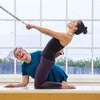Psoas
Lesley Powell
Tutorial 4060
Watch this Tutorial


Lyndie Butler-Bruce
Easy to understand Lesley, and very helpful. Im learning a lot from your anatomy videos, many thanks.
5 years ago
Love this! Thank you for the focus on the pelvis and psoas, looking forward to the upcoming videos.
5 years ago
Thank you so, so much. I think many of us have heard so often that a truly neutral spine and pelvis is the gateway to freedom of movement and supported range, but the search for it is much more complex than just the simple principle. So grateful for the generosity of true experts on this site. There can never be too many perspectives shared or too much discussion on this topic imo.
5 years ago
Thank you for the lecture. Do I understand correctly that you are talking about the psoas major minor and iliacus and their role in the gait? Are you referring to the rectus femoris and the pectineus when you mention hip flexors that substitute the actions of the psoas? Or are you also referring to the sartorius in that hip flexor role?
You are mentioning that if one hip is hiked up compensation happens. If one femur is longer than the other that is inevitable. Where can I lean more about these patterns of compensation?
In the exercise that you are showing the model is up on a bolster that puts her in increased hip flexion and being on a increases that further.in this position the teacher can see the spine position very well and the alignment of the legs and hips. The movement was hard for me to see but I thought that you were looking for even more hip flexion moving the knees one at a time towards the arms?
3 years ago
Copycat You have to look at the movement choices a client does with poor gait patterns. Every pattern invites a different phrasing. how is the client using their stance leg for the swing leg? When there is weakness in the gluts, how does the client propel forward? Hip hike? Waddling? Circumduction of swing leg? Gait is coordination. I look at what I think is overworking and then try to build the lesson plan increasing the places of lack of strength. When there is great dynamic change of alignment in gait, you are going to invite better phrasing of all the muscles of the body.
3 years ago
Hip hike could be a lack of strength of the standing leg or a poor pattern of of lifting the leg. As for understanding leg length difference, it is very hard. There are so many factors of design: head of femur head, shape of the pelvis, scoliosis, length of shaft of femur, tibia, foot bones, leg alignment,etc. The best way to know is an X-ray which I don't have the skills to read as a movement teacher.
The exercise on the bolster is to wake up the psoas. It is a very tiny movement with your spine in neutral. If the pelvis is moving, the client is using other muscles to initiate the movement.
3 years ago
Leslie thank you for your prompt response and apologies for delay in mine I was out of commission. I was trained to evaluate the elements of the gait ( hip hike, hip drop etc) rather than the overall gait. thank you for your suggestion I will look at the overall as well. I was told by an online group client that she had her femur broken and when set by the doctors one is longer. I did suggest measuring in x Ray. She is still young and in the group mat we class we do much that does not involve kneeling or standing so the length difference is not too disturbing. In a private lesson I might elevate the shorter femur. What do you think of that? I understand that the two femur bones may sit differently in the sockets so that may have to be addressed first.
3 years ago
As for the exercise kneeling on the bolster : so I watch the spine and the pelvic stability while the client moves her thigh forward . How many reps? Then check how she lifts one leg standing up watching spine pos and pelvic stability/ hike.
3 years ago
1-10 of 12
You need to be a subscriber to post a comment.
Please Log In or Create an Account to start your free trial.










